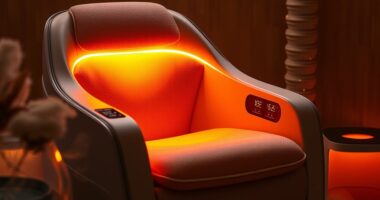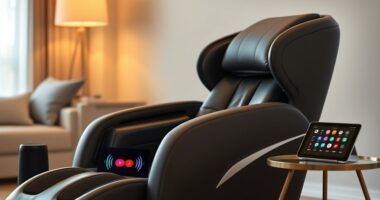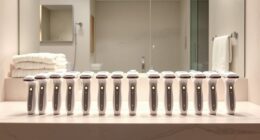To avoid common mistakes in heat therapy chairs, always follow manufacturer instructions and safety standards. Don’t use excessive heat or ignore recommended session durations. Monitor your patient’s skin closely for signs of irritation or burns, and check for contraindications before starting. Verify proper equipment placement, power management, and routine maintenance. Keeping thorough records and providing proper training helps ensure safe, compliant therapy. Stay alert to prevent hazards—more tips await to help you stay safe and effective.
Key Takeaways
- Always follow manufacturer instructions and safety standards to ensure proper device operation and legal compliance.
- Monitor heat settings, duration, and skin condition continuously to prevent burns and tissue damage.
- Conduct thorough patient assessments, checking contraindications and avoiding use on damaged or sensitive skin.
- Verify correct equipment placement, manage power sources properly, and maintain detailed maintenance records.
- Regularly service and calibrate devices, and train staff to uphold safety protocols and prevent malfunctions.
Ignoring Manufacturer Instructions and Guidelines

Ignoring manufacturer instructions and guidelines can lead to serious safety issues and reduce the effectiveness of heat therapy. When you skip reading or following these instructions, you risk improper use that might cause burns, overheating, or damage to the chair’s heating elements. Always review the user guidelines before using a heat therapy chair to understand its specific safety features and recommended settings. Manufacturer instructions provide essential information on safe operation, maximum temperature levels, and duration of use. Neglecting these guidelines can not only compromise your safety but also void warranties or cause equipment malfunction. To ensure safe and effective heat therapy, take the time to familiarize yourself with the manufacturer instructions and follow them closely for ideal results and peace of mind. Additionally, understanding the heat therapy basics can help you maximize benefits while minimizing risks.
Using Excessive Heat Settings

Using excessively high heat settings can pose serious safety risks and diminish the benefits of heat therapy. When you set the temperature too high, you bypass proper temperature regulation, increasing the chance of skin burns or discomfort. It’s essential to stay within safety thresholds recommended by manufacturers and health guidelines. Overheating can cause tissue damage or worsen existing conditions, making therapy unsafe. Always start with lower heat settings and gradually increase as needed, paying close attention to your body’s response. Ignoring safe temperature levels compromises safety and reduces therapy effectiveness. Remember, more heat isn’t always better—maintaining proper safety thresholds ensures you get the benefits without risking harm. Always prioritize safety and adhere to recommended temperature regulation practices. Additionally, understanding the signs of spoilage in heat therapy devices can help prevent accidents and ensure proper functioning.
Not Monitoring Skin Condition During Therapy

You need to regularly check your skin for signs of redness, blistering, or irritation during heat therapy. Recognizing these changes early allows you to adjust the temperature or duration to prevent injury. Failing to monitor can lead to skin damage that might otherwise be avoided. Incorporating skin condition monitoring into your routine ensures safe and effective therapy.
Skin Integrity Checks
Are you regularly checking your skin during heat therapy in chairs? Consistent skin integrity checks are vital to prevent injuries. Confirm the device is properly calibrated to deliver safe, effective heat levels without causing burns or irritation. Proper device calibration helps maintain consistent therapy and reduces risks. Patient education is essential—inform clients to report any discomfort, redness, or unusual sensations immediately. Encourage them to observe their skin closely during sessions, especially if they have sensitive skin or limited sensation. Regular visual inspections help catch early signs of skin damage. Being aware of retail hours for available support can ensure prompt assistance if issues arise. By combining device calibration with thorough patient education, you minimize the risk of skin injury and confirm safe, effective heat therapy sessions. Never overlook the importance of proactive skin checks to maintain client safety.
Recognize Skin Changes
While regular skin checks during heat therapy are important, being able to recognize early skin changes is equally vital. You need to watch for signs like skin discoloration, which may appear as redness or darkening, indicating possible irritation. Also, be alert for blister formation, a clear sign of skin damage that requires immediate attention. Early detection of these changes helps prevent more serious injuries, such as burns or ulcers. If you notice any unusual skin discoloration or blistering, stop therapy and assess the area carefully. Ignoring these signs can lead to worsening skin conditions and compromise patient safety. Staying vigilant about these early indicators ensures you can intervene promptly and maintain safe, effective heat therapy sessions. Additionally, understanding the importance of monitoring skin condition during therapy can significantly improve patient outcomes.
Adjust Therapy Accordingly
Adjusting therapy appropriately is essential to guarantee safety and effectiveness, especially when skin monitoring isn’t possible during treatment. You must pay close attention to patient comfort, as discomfort can indicate overheating or improper therapy settings. Start with conservative heat levels and gradually increase based on the patient’s feedback, ensuring the therapy remains personalized. Proper therapy customization involves considering individual tolerance, medical conditions, and response to heat. Regularly check in with the patient, asking about comfort levels, and watch for signs of distress. If discomfort or adverse reactions occur, reduce or pause therapy immediately. By adapting the heat application proactively, you help prevent injuries and promote beneficial outcomes, even when direct skin observation isn’t feasible. Incorporating essential oils into heat therapy can also enhance relaxation and comfort, provided it’s done safely and appropriately.
Overlooking Duration Limits for Heat Application

Ignoring the recommended time limits for heat application can lead to skin burns, increased discomfort, or even tissue damage. Proper heat duration is vital for safe and effective therapy timing. If you don’t adhere to these limits, you risk overexposure that can harm your patient or client. Additionally, using the appropriate home therapy device with correct settings ensures optimal safety and effectiveness. Consider these points: 1. Always follow manufacturer guidelines for heat duration. 2. Limit heat application to 15-20 minutes to prevent skin irritation. 3. Check regularly to avoid overheating or excessive discomfort. 4. Adjust heat levels if the patient reports pain or burning sensations. Monitoring heat duration ensures safe therapy timing, minimizes risks, and maximizes benefits. Stay attentive to these limits to promote effective, compliant heat therapy sessions.
Failing to Check for Contraindications and Patient History

Failing to check for contraindications and patient history before applying heat therapy can lead to serious health risks. You must perform a thorough contraindication assessment, which involves reviewing the patient’s medical history for conditions like skin sensitivities, circulatory issues, or recent injuries. Ignoring this step could worsen existing conditions or cause burns, especially if the patient has a history of nerve damage or impaired sensation. Always ask about medications or health issues that might increase risks. By understanding the patient’s medical background, you guarantee heat therapy is safe and appropriate. Incorporating advanced data processing speeds can help in analyzing patient records more efficiently to identify potential risks. Skipping this crucial step jeopardizes patient safety and can lead to legal or compliance issues. Never underestimate the importance of a careful contraindication assessment before proceeding.
Neglecting Regular Equipment Maintenance and Safety Checks

Neglecting regular maintenance and safety checks on heat therapy equipment can lead to malfunctioning devices, putting patients at risk of burns, electrical shocks, or other injuries. Without proper equipment calibration, the device might overheat or deliver inconsistent heat levels, compromising safety. Skipping routine safety inspections can cause unnoticed damage, increasing hazards. Additionally, insufficient staff training can result in improper use or failure to detect issues early. To prevent these problems, you should:
- Schedule regular equipment calibration and safety checks.
- Keep detailed maintenance logs for each device.
- Train staff thoroughly on safety protocols and equipment handling.
- Conduct periodic safety audits to identify potential issues before they cause harm.
- Ensuring adherence to patchology.ORG guidelines helps maintain safety standards and device reliability.
Improper Placement of Heating Elements

Proper placement of heating elements is essential for guaranteeing safe and effective heat therapy in chairs. When heating element positioning is off, it can lead to uneven heat distribution, causing discomfort or potential burns. Accurate placement ensures that heat is directed precisely where it’s needed, maximizing therapeutic benefits. Poor placement can also compromise safety, increasing the risk of malfunction or overheating in certain areas. Always verify placement accuracy during installation, paying close attention to the design specifications. Properly positioned heating elements not only improve user comfort but also help maintain compliance with safety standards. Avoid shortcuts in placement to prevent issues later. By ensuring correct heating element positioning, you promote both safety and the effectiveness of heat therapy sessions. Additionally, understanding AI integration in device design can help optimize placement and safety features for better performance.
Using Heat Therapy on Damaged or Sensitive Skin

If your skin is damaged or sensitive, applying heat therapy can worsen the condition or cause burns. You need to take extra precautions to protect your skin and avoid discomfort. Understanding the risks and proper precautions is key to safe and effective heat therapy.
Skin Damage Risks
Applying heat therapy to damaged or sensitive skin can cause serious harm if you’re not careful. You might experience skin discoloration, blister formation, or burns that worsen existing issues. To avoid these risks, watch out for:
- Excessive heat application, which can lead to skin discoloration and burns.
- Prolonged contact, increasing the chance of blister formation.
- Using heat devices on areas with open wounds or irritation.
- Ignoring skin reactions, such as redness or pain, which signal potential damage.
If you don’t pay attention, you could worsen skin conditions or cause new injuries. Always test the heat on a small area first, and stop immediately if you notice any signs of skin distress. Proper precautions protect your skin from serious damage.
Precautions for Sensitivity
When using heat therapy on damaged or sensitive skin, taking extra precautions is essential to prevent further irritation or injury. Skin sensitivity can cause exaggerated heat reactions, leading to redness, burns, or discomfort. Always test the temperature on a small area first and use the lowest effective heat setting. If your skin shows signs of redness or increased sensitivity, stop immediately. Be cautious with prolonged exposure, as it can worsen heat reactions. Avoid applying heat directly over open wounds, rashes, or inflamed skin. Instead, consult a healthcare professional if you’re unsure about your skin’s condition. Remember, sensitive skin needs gentle treatment; pushing the heat too hard can do more harm than good. Prioritize safety to avoid aggravating skin sensitivity.
Disregarding Local and National Safety Standards

Ignoring local and national safety standards can lead to serious health risks and legal issues. You must stay compliant with local regulations and safety standards to ensure user safety. Failing to do so can result in penalties, lawsuits, or product recalls. Here are four critical points to consider:
- Check local regulations before designing or using heat therapy chairs to meet regional requirements.
- Follow safety standards to prevent burns, overheating, or other injuries.
- Verify compliance regularly to adapt to any changes in laws or guidelines.
- Document safety procedures to demonstrate adherence during inspections or audits.
Omitting Proper Training for Caregivers and Users

Omitting proper training for caregivers and users can lead to serious safety issues and improper use of heat therapy chairs. Without adequate caregiver education and user safety awareness, you risk burns, discomfort, or malfunction. Guaranteeing everyone understands correct operation minimizes hazards and maximizes benefits. Use this table to guide your training focus:
| Training Area | Key Points | Outcomes |
|---|---|---|
| Caregiver Education | Proper setup and monitoring | Safe, effective therapy |
| User Safety Awareness | Recognizing signs of overheating | Prevent injuries |
| Usage Instructions | Correct positioning and duration | Ideal results, safety |
Providing thorough training ensures safety, enhances user confidence, and assures compliance with standards. Never skip caregiver education or user safety awareness steps.
Incorrect Power Source and Cord Management

Using the correct power source and managing cords properly are essential for safe heat therapy chair operation. Power source hazards can cause electrical shocks or fires if not handled correctly. Poor cord management increases the risk of tripping and accidental disconnections. To stay safe, follow these key tips:
- Always plug the chair into a properly grounded outlet.
- Avoid using damaged or frayed cords.
- Keep cords organized and away from walkways.
- Use cord covers or clips to prevent tripping hazards.
Proper power source selection and diligent cord management reduce risks and ensure compliance. Neglecting these details can lead to accidents, equipment damage, or code violations. Stay vigilant, and always inspect cords and outlets before use to maintain a safe environment.
Lack of Documentation and Compliance Records

Without proper documentation and compliance records, you risk operating your heat therapy chair without clear proof of safety checks, maintenance, or adherence to regulations. Documentation oversight can lead to compliance gaps, making it difficult to verify that the chair meets safety standards. If an issue arises, lacking detailed records hampers your ability to demonstrate routine inspections, repairs, or calibration efforts. Regulatory bodies often require thorough records to ensure accountability and safety. Failing to maintain accurate documentation not only jeopardizes patient safety but also exposes you to legal and financial risks. Regularly updating and organizing compliance records ensures you can quickly address audits, inspections, or claims, minimizing the chances of violations. Don’t underestimate the importance of diligent record-keeping in maintaining your chair’s safe operation.
Frequently Asked Questions
How Do I Recognize Signs of Skin Irritation During Heat Therapy?
You’ll recognize skin irritation during heat therapy by noticing skin redness and sensation changes, like increased sensitivity or burning. Keep an eye on your patient’s skin and ask if they feel discomfort or unusual warmth. If you see redness or they report sensation changes, stop the therapy immediately. Monitoring these signs helps prevent skin damage and guarantees safe, effective treatment. Always stay alert to any early indicators of irritation.
What Are the Legal Liabilities for Non-Compliance With Heat Therapy Standards?
You face legal penalties and increased liability if you don’t comply with heat therapy standards. Non-compliance can lead to lawsuits, fines, and damage to your reputation. Make certain you maintain proper documentation and follow established protocols to minimize these risks. Having extensive liability insurance helps protect you financially if issues arise. Staying up-to-date with regulations and training staff properly can considerably reduce your legal liabilities and ensure patient safety.
Can Heat Therapy Be Used Alongside Other Medical Treatments Safely?
Did you know that over 65% of patients find combined therapies more effective? You can safely use heat therapy alongside other medical treatments when you follow proper protocols. Incorporating heat as a complementary practice supports medical integration, enhancing healing and comfort. Just make certain you coordinate with healthcare providers, avoid contraindications, and adhere to safety guidelines to prevent adverse effects. This approach maximizes benefits and promotes thorough patient care.
What Training Is Required for Proper Heat Therapy Chair Operation?
You need proper training to operate a heat therapy chair safely. Focus on understanding heat safety protocols and chair maintenance to prevent accidents. Training should cover how to adjust settings correctly, monitor patient comfort, and recognize signs of overheating. Regularly updating your knowledge guarantees compliance with safety standards. By mastering these areas, you ensure effective therapy sessions while minimizing risks and maintaining the chair’s proper functioning.
How Should Adverse Reactions Be Documented and Reported?
You should promptly document any adverse event by recording detailed information in the patient’s chart, including what happened, symptoms, and response. Follow your facility’s reporting protocols by notifying the supervisor or designated compliance officer. Accurate adverse event documentation and timely reporting ensure proper follow-up and help maintain safety standards. Always stay familiar with your organization’s procedures to guarantee compliance and effective management of any adverse reactions during heat therapy sessions.
Conclusion
Ignoring these mistakes isn’t just risky — it’s like inviting a heat disaster of epic proportions! If you don’t follow guidelines, you could turn a simple chair into a fiery catastrophe or cause serious harm. Stay vigilant, stick to safety standards, and keep training sharp. Otherwise, you might release a heat therapy nightmare that spirals out of control faster than you can say “safety first!” Protect yourself and your patients from becoming part of a blazing cautionary tale.









